Temperature and Pulse-Energy Range Suitable for Femtosecond Pulse Transmission in Si Nanowire Waveguide
Abstract
:1. Introduction
2. Measurement Details
3. Experimental Results
4. Analysis and Discussion
5. Conclusions
Author Contributions
Funding
Acknowledgments
Conflicts of Interest
References
- Almeida, V.R.; Barrios, C.A.; Panepucci, R.R.; Lipson. M. All-optical control of light on a silicon chip. Nature 2004, 431, 1081–1084. [Google Scholar] [CrossRef]
- Dai, D.; Bowers, J.E. Novel concept for ultracompact polarization splitter-rotator based on silicon nanowires. Opt. Express 2011, 19, 10940–10949. [Google Scholar] [CrossRef] [Green Version]
- Foster, M.A.; Turner, A.C.; Lipson, M.; Gaeta, A.L. Nonlinear optics in photonic nanowires. Opt. Express 2008, 16, 1300–1320. [Google Scholar] [CrossRef] [PubMed]
- Velasco, A.V.; Cheben, P.; Bock, P.J.; Delâge, A.; Schmid, J.H.; Lapointe, J.; Janz, S.; Calvo, M.L.; Xu, D.; Czyk, M.A.F.; et al. High-resolution Fourier-transform spectrometer chip with microphotonic silicon spiral waveguides. Opt. Lett. 2013, 38, 706–708. [Google Scholar] [CrossRef] [PubMed]
- Liu, K.; Xu, W.; Zhu, Z.H.; Ye, W.M.; Yuan, X.D.; Zeng, C. Wave propagation in deep-subwavelength mode waveguides. Opt. Lett. 2012, 37, 2826–2828. [Google Scholar] [CrossRef] [PubMed]
- Tan, D.T.H.; Sun, P.C.; Fainman, Y. Monolithic nonlinear pulse compressor on a silicon chip. Nat. Commun. 2010, 1, 116. [Google Scholar] [CrossRef] [Green Version]
- Foster, M.A.; Gaeta, A.L.; Cao, Q.; Trebino, R. Soliton-effect compression of supercontinuum to few-cycle durations in photonic nanowires. Opt. Express 2005, 13, 6848–6855. [Google Scholar] [CrossRef]
- Zhou, H.; Huang, S.; Li, X.; McMillan, J.F.; Zhang, C.; Wong, K.K.; Yu, M.; Lo, G.; Kwong, D.; Qiu, K.; et al. Real-time dynamics and cross-correlation gating spectroscopy of free-carrier Drude slow-light solitons. Light Sci. Appl. 2017, 6, P49–P56. [Google Scholar] [CrossRef] [Green Version]
- Driscoll, J.B.; Ophir, N.; Grote, R.R.; Dadap, J.I.; Panoiu, N.C.; Bergman, K.; Osgood, R.M. Width-modulation of Si photonic wires for quasi-phase-matching of four-wave-mixing: Experimental and theoretical demonstration. Opt. Express 2012, 20, 9227–9242. [Google Scholar] [CrossRef]
- McMillan, J.F.; Yu, M.; Kwong, D.-L.; Wong, C.W. Observations of four-wave mixing in slow-light silicon photonic crystal waveguides. Opt. Express 2010, 18, 15484–15497. [Google Scholar] [CrossRef] [Green Version]
- Kuyken, B.; Verheyen, P.; Tannouri, P.; Liu, X.; Campenhout, J.V.; Baets, R.; Green, W.M.J.; Roelkens, G. Generation of 3.6 μm radiation and telecom-band amplification by four-wave mixing in a silicon waveguide with normal group velocity dispersion. Opt. Lett. 2014, 39, 1349–1352. [Google Scholar] [CrossRef] [Green Version]
- Yin, L.; Zhang, J.; Fauchet, P.M.; Agrawal, G.P. Optical switching using nonlinear polarization rotation inside silicon waveguides. Opt. Lett. 2009, 34, 476–478. [Google Scholar] [CrossRef]
- Jacome, K.L.; Poulton, C.; Leuthold, J.; Freude, W. Nonlinear silicon-on-insulator waveguides for all-optical signal processing. Opt. Express 2007, 15, 5976–5990. [Google Scholar]
- Husko, C.A.; Rossi, A.; Combrie, S.; Tran, Q.V.; Raineri, F.; Wong, C.W. Ultrafast all-optical modulation in GaAs photonic crystal cavities. Appl. Phys. Lett. 2009, 94, 021111. [Google Scholar] [CrossRef]
- Colman, P.; Husko, C.; Combrie, S.; Sagnes, I.; Wong, C.W.; de Rossi, A. Temporal solitons and pulse compression in photonic crystal waveguides. Nat. Photonics 2010, 4, 862–868. [Google Scholar] [CrossRef]
- Kondo, K.; Baba, T. Dynamic wavelength conversion in copropagating slow-light pulses. Phys. Rev. Lett. 2014, 112, 223904. [Google Scholar] [CrossRef]
- Wakabayashi, R.; Fujiwara, M.; Yoshino, K.; Nambu, Y.; Sasaki, M.; Aoki, T. Time-bin entangled photon pair generation from Si micro-ring resonator. Opt. Express 2015, 23, 1103–1113. [Google Scholar] [CrossRef] [Green Version]
- Uddin, M.R.; Lingas, N.A.; Nakarmi, B.; Won, Y.H. Waveguide side-wall angle dependant resonance of a Si micro ring-resonato. In Proceedings of the Conference on Lasers and Electro-Optics Pacific Rim Optical Society of America, Busan, Korea, 24–28 August 2015. [Google Scholar]
- Guha, B.; Cardenas, J.; Lipson, M. Athermal silicon microring resonators with titanium oxide cladding. Opt. Express 2013, 21, 26557–26563. [Google Scholar] [CrossRef] [Green Version]
- Teng, J.; Dumon, P.; Bogaerts, W.; Zhang, H.; Jian, X.; Han, X.; Zhao, M.; Morthier, G.; Baets, R. Athermal Silicon-on-insulator ring resonators by overlaying a polymer cladding on narrowed waveguides. Opt. Express 2009, 17, 14627–14632. [Google Scholar] [CrossRef] [Green Version]
- Nguyen, H.C.; Sakai, Y.; Shinkawa, M.; Ishikura, N.; Baba, T. Photonic crystal silicon optical modulators carrier-injection and depletion at 10 Gb/s. IEEE J. Quantum Electron. 2012, 48, 210–220. [Google Scholar] [CrossRef]
- Guan, X.; Wang, X.; Frandsen, L.H. Optical temperature sensor with enhanced sensitivity by employing hybrid waveguides in a silicon Mach-Zehnder interferometer. Opt. Express 2016, 24, 16349–16356. [Google Scholar] [CrossRef] [PubMed] [Green Version]
- Klimov, N.N.; Mittal, S.; Berger, M.; Ahmed, Z. On-chip silicon waveguide Bragg grating photonic temperature sensor. Opt. Lett. 2015, 40, 3934–3936. [Google Scholar] [CrossRef] [PubMed]
- Furukawa, K.; Ohsuye, K. Effect of culture temperature on a recombinant CHO cell line producing a Cterminal α-amidating enzyme. Cytotechnology 1998, 26, 153–164. [Google Scholar] [CrossRef] [PubMed]
- Trenti, A.; Borghi, M.; Biasi, S.; Ghulinyan, M.; Ramiro-Manzano, F.; Pucker, G.; Pavesi, L. Thermo-optic coefficient and nonlinear refractive index of silicon oxynitride waveguides. AIP Adv. 2018, 8, 025311. [Google Scholar] [CrossRef]
- Sinclair, G.F.; Tyler, N.A.; Barreto, D.S.J.; Thompson, M.G. Temperature dependence of the Kerr nonlinearity and two-photon absorption in a silicon waveguide at 1.55 μm. Phys. Rev. Appl. 2019, 11, 044084. [Google Scholar] [CrossRef] [Green Version]
- Tanaka, Y.; Tominaka, S.; Kurokawa, T. Precision distance measurement using a twophoton absorption process in a silicon avalanche photodiode with saw-tooth phase modulation. Appl. Opt. 2015, 54, E35–E40. [Google Scholar] [CrossRef]
- Arbabi, A.; Goddard, L.L. Measurements of the refractive indices and thermo-optic coefficients of Si3N4 and SiOx using microring resonances. Opt. Lett. 2013, 38, 3878–3881. [Google Scholar] [CrossRef]
- Uenuma, M.; Moooka, T. Temperature-independent silicon waveguide optical filter. Opt. Lett. 2009, 34, 599–601. [Google Scholar] [CrossRef]
- Guan, X.; Frandsen, L.H. All-silicon interferometer with multimode waveguides for temperature-insensitive filters and compact biosensors. Opt. Express 2019, 27, 753–760. [Google Scholar] [CrossRef]
- Yin, L.; Lin, Q.; Agrawal, G.P. Soliton fission and supercontinuum generation in silicon waveguides. Opt. Lett. 2007, 32, 391–393. [Google Scholar] [CrossRef]
- Fleischer, J.W.; Segev, M.; Efremidis, N.K.; Christodoulides, D.N. Observation of two-dimensional discrete solitons in optically-induced nonlinear photonic lattices. Nature 2003, 422, 147–150. [Google Scholar] [CrossRef] [PubMed]
- Reid, D.T.; Loza-Alvarez, P.; Brown, C.T.A.; Beddard, T.; Sibbett, W. Amplitude and phase measurement of mid-infrared femtosecond pulses by using cross-correlation frequency-resolved optical gating. Opt. Lett. 2000, 25, 1478–1480. [Google Scholar] [CrossRef] [PubMed]
- Parker, D.S.N.; Nunn, A.D.G.; Minns, R.S.; Fielding, H.H. Frequency doubling and fourier domain shaping the output if a femtosecond optical parametric amplifier: Easy access to tuneable femtosecond pulse shapes in the deep ultraviolet. Appl. Phys. B 2009, 94, 181–186. [Google Scholar] [CrossRef]
- Liao, J.; Marko, M.; Li, X.; Jia, H.; Liu, J.; Tan, Y.; Yang, J.; Zhang, Y.; Tang, W.; Yu, M.; et al. Cross-correlation frequency-resolved optical gating and dynamics of temporal solitons in silicon nanowire waveguides. Opt. Lett. 2013, 38, 4401–4404. [Google Scholar] [CrossRef] [PubMed]
- Nikitin, A.A.; Kondrashov, A.V.; Vitko, V.V.; Ryabcev, L.A.; Zaretskaya, G.A.; Cheplagin, N.A.; Konkin, D.A.; Kokolov, A.A.; Babak, L.I.; Ustinov, A.B.; et al. Carrier-induced optical bistability in the silicon micro-ring resonators undercontinuous wave pumping. Opt. Commun. 2020, 480, 126456. [Google Scholar] [CrossRef]

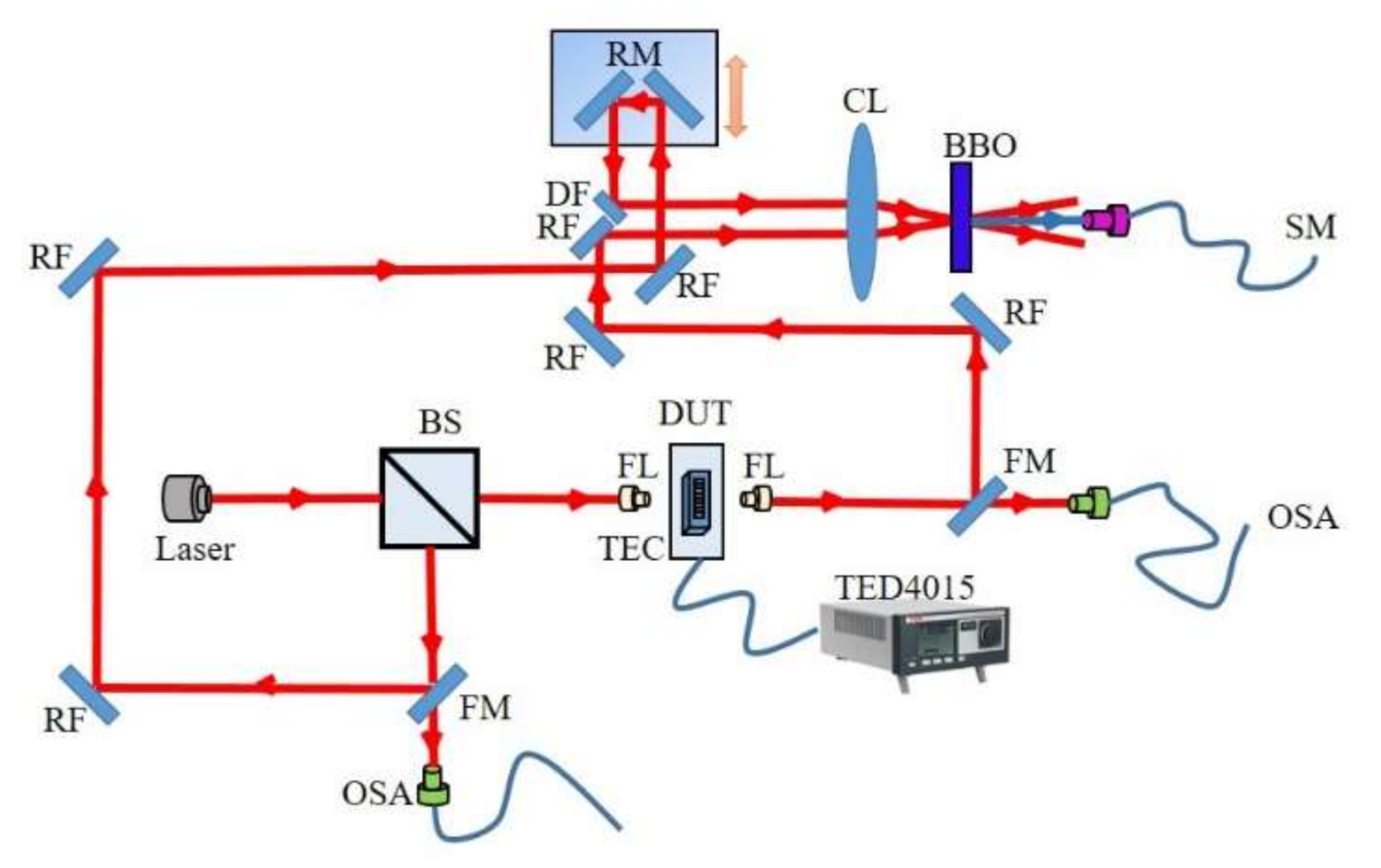



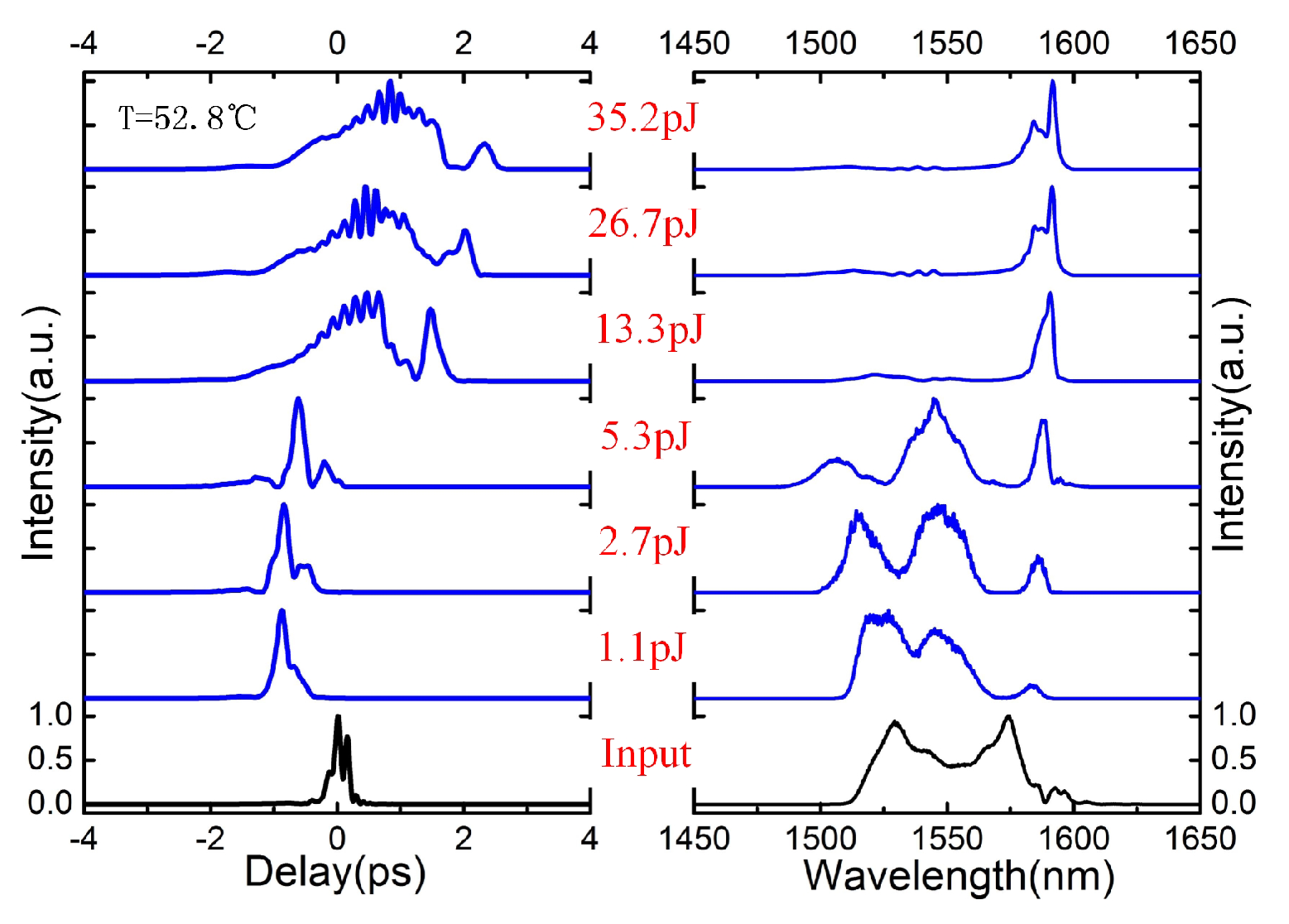

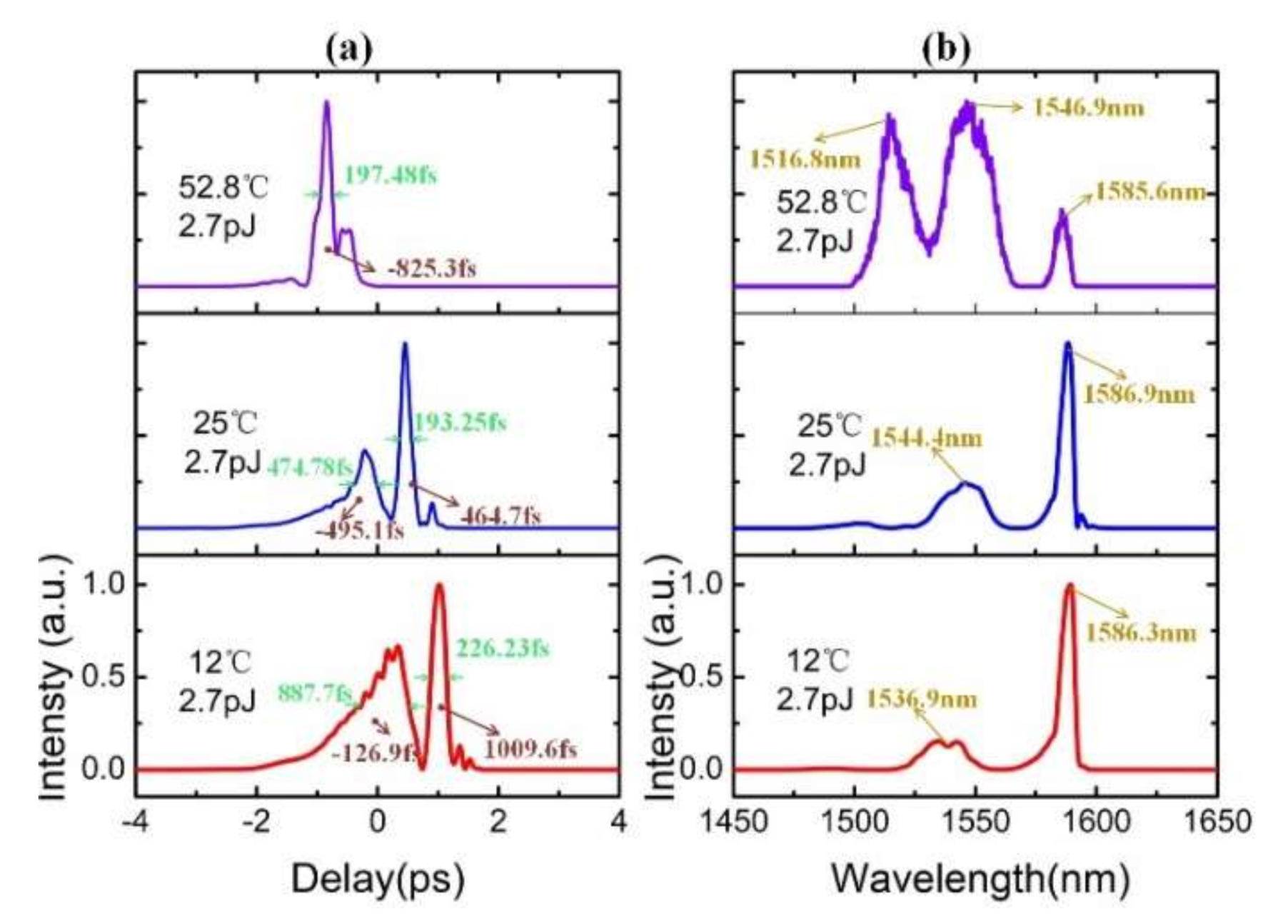
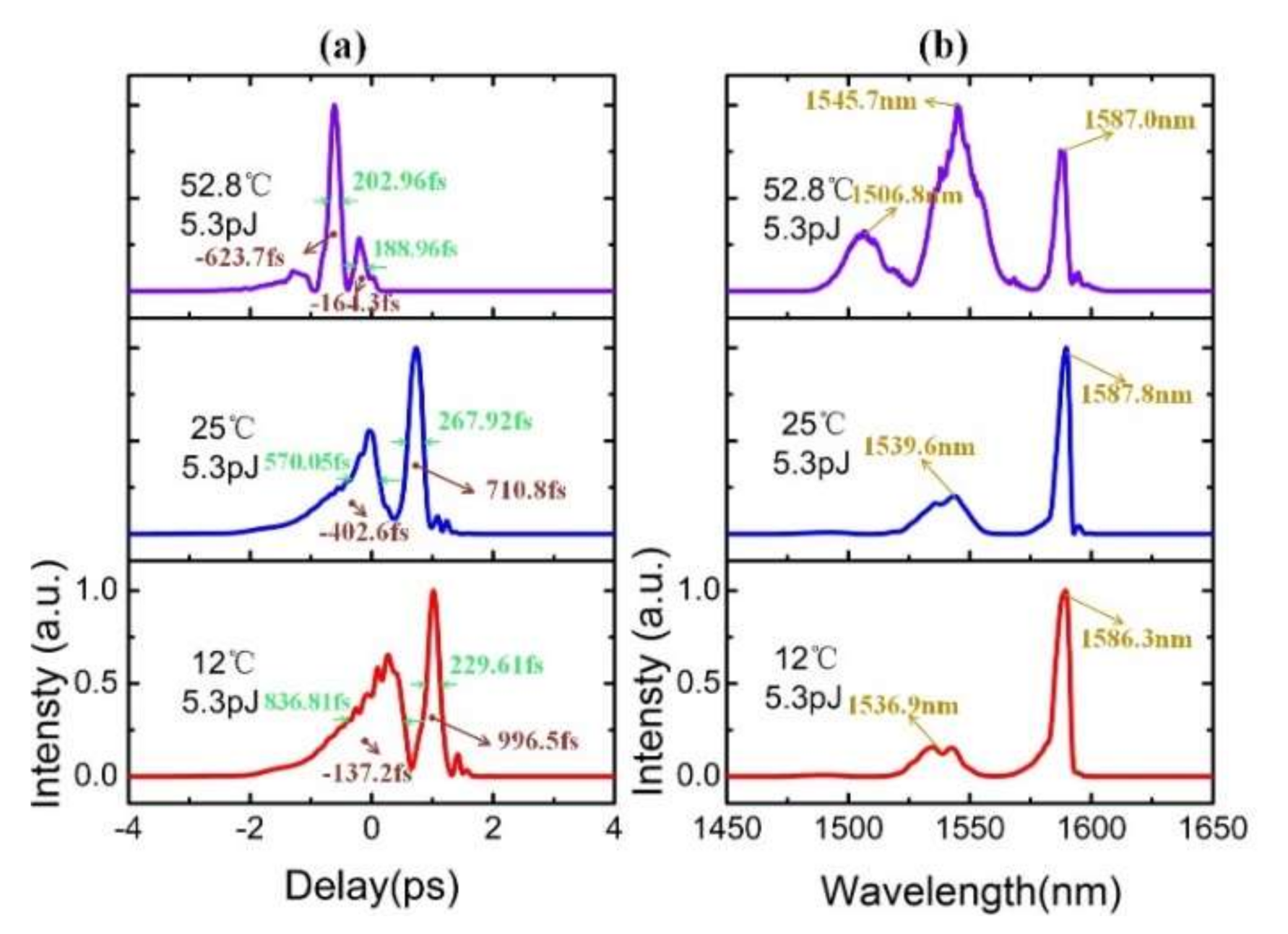


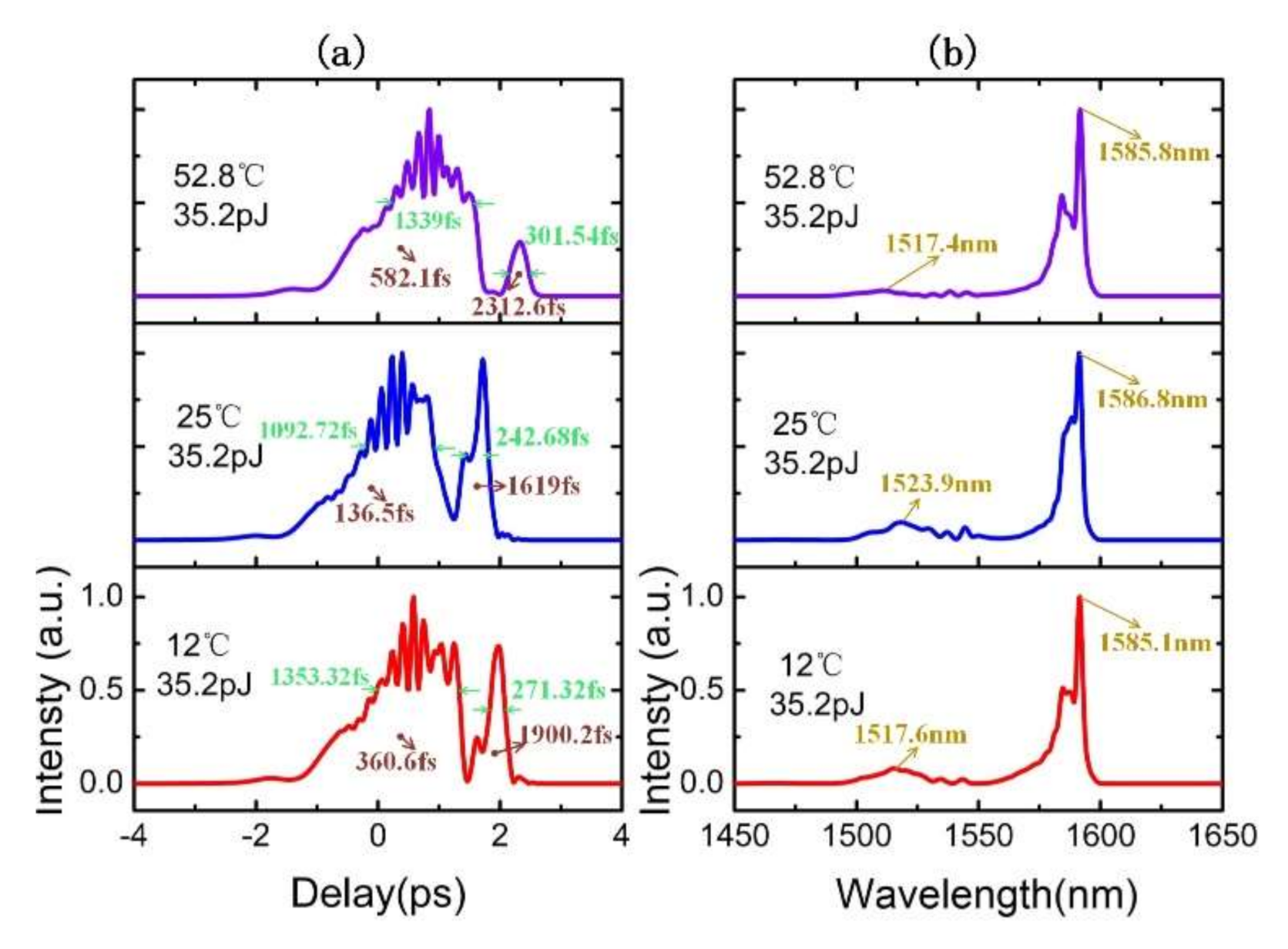
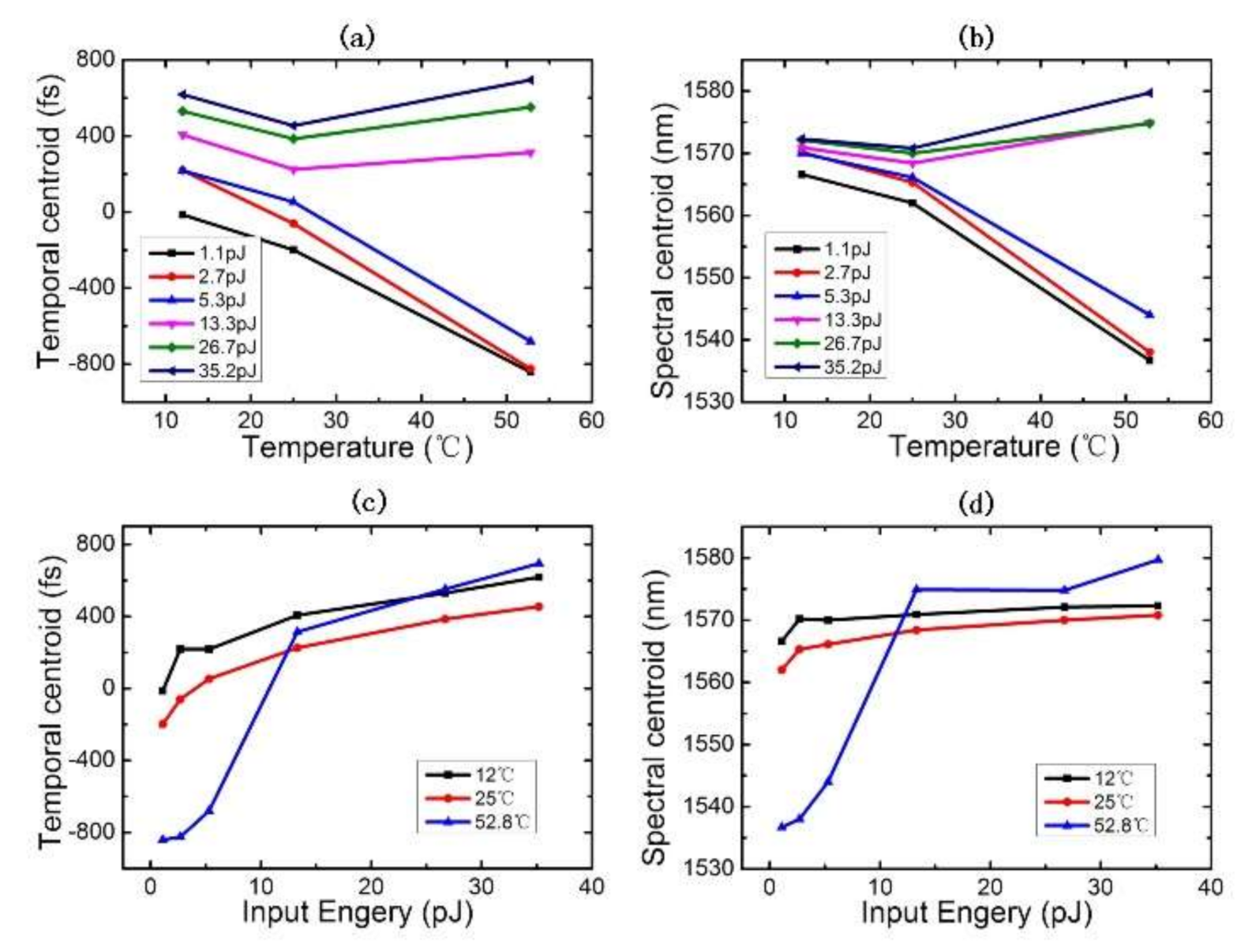
| Pulse Energy (pJ) | 12.0 °C | 25.0 °C | 52.8 °C | ||||||
|---|---|---|---|---|---|---|---|---|---|
| FWHM (fs) | FWHM (fs) | FWHM (fs) | |||||||
| Ahead | Back | Total | Ahead | Back | Total | Ahead | Back | Total | |
| 1.1 | 649.15 | 208.48 | 208.48 | 484.48 | 194.10 | 194.10 | 195.36 | NON | 195.36 |
| 2.7 | 887.7 | 226.23 | 226.23 | 474.78 | 193.25 | 193.25 | 197.48 | NON | 197.48 |
| 5.3 | 836.81 | 229.61 | 229.61 | 570.05 | 267.92 | 267.92 | 202.96 | 188.96 | 202.96 |
| 13.3 | 1135.16 | 273.88 | 273.88 | 1046.80 | 321.30 | 321.30 | 1046.63 | 225.64 | 1046.63 |
| 26.7 | 1230.85 | 276.72 | 1230.85 | 1126.26 | 246.35 | 246.35 | 1125.00 | 378.96 | 1125.00 |
| 35.2 | 1353.32 | 271.32 | 1353.32 | 1092.72 | 242.68 | 242.68 | 1339.00 | 301.54 | 1339.00 |
| Pulse Energy (pJ) | 12.0 °C | 25.0 °C | 52.8 °C | ||||||
|---|---|---|---|---|---|---|---|---|---|
| Centroid (nm) | Centroid (nm) | Centroid (nm) | |||||||
| Left | Center | Right | Left | Center | Right | Left | Center | Right | |
| 1.1 | 1548.4 | NON | 1584.3 | 1547.9 | NON | 1585.1 | 1524.5 | 1548.9 | 1582.9 |
| 2.7 | 1536.9 | NON | 1586.3 | 1544.4 | NON | 1586.9 | 1516.8 | 1546.9 | 1585.6 |
| 5.3 | 1536.9 | NON | 1586.3 | 1539.6 | NON | 1587.8 | 1506.8 | 1545.7 | 1587.0 |
| 13.3 | 1527.0 | NON | 1586.2 | 1531.4 | NON | 1587.9 | 1528.9 | NON | 1587.6 |
| 26.7 | 1520.1 | NON | 1585.3 | 1525.9 | NON | 1587.2 | 1519.3 | NON | 1586.1 |
| 35.2 | 1517.6 | NON | 1585.1 | 1523.9 | NON | 1586.8 | 1517.4 | NON | 1585.8 |
| Pulse Energy (pJ) | 12.0 °C | 25.0 °C | 52.8 °C | ||||||
|---|---|---|---|---|---|---|---|---|---|
| Centroid (fs) | Centroid (fs) | Centroid (fs) | |||||||
| Ahead | Back | Total | Ahead | Back | Total | Ahead | Back | Total | |
| 1.1 | −423.6 | 463.6 | −14.1 | −674.0 | 153.1 | −199.0 | NON | NON | −842.0 |
| 2.7 | −126.9 | 1009.6 | 218.9 | −495.1 | 464.7 | −60.1 | NON | NON | −825.3 |
| 5.3 | −137.2 | 996.5 | 217.5 | −402.6 | 710.8 | 53.1 | −623.7 | −164.3 | −680.3 |
| 13.3 | 105.4 | 1455.0 | 406.5 | 175.5 | 1105.1 | 224.7 | 101.5 | 1519.8 | 313.1 |
| 26.7 | 192.9 | 1608.5 | 529.8 | 35.2 | 1474.4 | 384.9 | 346.0 | 1950.2 | 551.9 |
| 35.2 | 360.6 | 1900.2 | 617.9 | 136.5 | 1619.0 | 454.0 | 582.1 | 2312.6 | 694.0 |
Publisher’s Note: MDPI stays neutral with regard to jurisdictional claims in published maps and institutional affiliations. |
© 2020 by the authors. Licensee MDPI, Basel, Switzerland. This article is an open access article distributed under the terms and conditions of the Creative Commons Attribution (CC BY) license (http://creativecommons.org/licenses/by/4.0/).
Share and Cite
Wang, X.; Fu, M.; Yang, H.; Liao, J.; Li, X. Temperature and Pulse-Energy Range Suitable for Femtosecond Pulse Transmission in Si Nanowire Waveguide. Appl. Sci. 2020, 10, 8429. https://doi.org/10.3390/app10238429
Wang X, Fu M, Yang H, Liao J, Li X. Temperature and Pulse-Energy Range Suitable for Femtosecond Pulse Transmission in Si Nanowire Waveguide. Applied Sciences. 2020; 10(23):8429. https://doi.org/10.3390/app10238429
Chicago/Turabian StyleWang, Xiaochun, Meicheng Fu, Heng Yang, Jiali Liao, and Xiujian Li. 2020. "Temperature and Pulse-Energy Range Suitable for Femtosecond Pulse Transmission in Si Nanowire Waveguide" Applied Sciences 10, no. 23: 8429. https://doi.org/10.3390/app10238429





